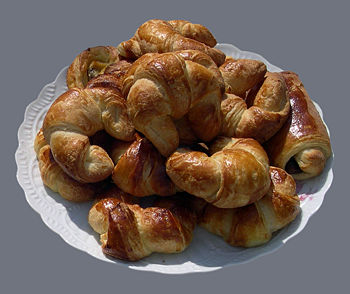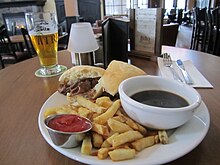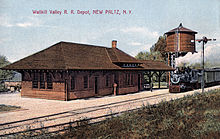Portal:Food
F o o d
A portal dedicated to food and foodways
Introduction


Food is any substance consumed by an organism for nutritional support. Food is usually of plant, animal, or fungal origin and contains essential nutrients such as carbohydrates, fats, proteins, vitamins, or minerals. The substance is ingested by an organism and assimilated by the organism's cells to provide energy, maintain life, or stimulate growth. Different species of animals have different feeding behaviours that satisfy the needs of their metabolisms and have evolved to fill a specific ecological niche within specific geographical contexts.
Omnivorous humans are highly adaptable and have adapted to obtain food in many different ecosystems. Humans generally use cooking to prepare food for consumption. The majority of the food energy required is supplied by the industrial food industry, which produces food through intensive agriculture and distributes it through complex food processing and food distribution systems. This system of conventional agriculture relies heavily on fossil fuels, which means that the food and agricultural systems are one of the major contributors to climate change, accounting for as much as 37% of total greenhouse gas emissions. (Full article...)
Cooking, also known as cookery or professionally as the culinary arts, is the art, science and craft of using heat to make food more palatable, digestible, nutritious, or safe. Cooking techniques and ingredients vary widely, from grilling food over an open fire, to using electric stoves, to baking in various types of ovens, reflecting local conditions. Cooking is an aspect of all human societies and a cultural universal.
Preparing food with heat or fire is an activity unique to humans. Archeological evidence of cooking fires from at least 300,000 years ago exists, but some estimate that humans started cooking up to 2 million years ago.
The expansion of agriculture, commerce, trade, and transportation between civilizations in different regions offered cooks many new ingredients. New inventions and technologies, such as the invention of pottery for holding and boiling of water, expanded cooking techniques. Some modern cooks apply advanced scientific techniques to food preparation to further enhance the flavor of the dish served. (Full article...)
Glamorgan sausage (Welsh: Selsig Morgannwg) is a traditional Welsh vegetarian sausage for which the main ingredients are cheese (usually Caerphilly), leeks and breadcrumbs. It is named after the historic county of Glamorgan in Wales.
The earliest published mention of the dish is from the 1850s in the book Wild Wales by George Borrow, although earlier records in the Glamorgan Archives show a version which contains pork. The modern vegetarian version became popular during the Second World War when meat was harder to come by, and is now mass-produced by at least two companies. Variations include swapping the leeks for onions, as well as different herbs and spices, and various types of cheese. (Full article...)
Selected article –

Snake soup or stew (Chinese: 蛇羹; pinyin: shé gēng; Jyutping: se4 gang1) is a popular Cantonese delicacy and health supplement in Hong Kong, which contains the meats of at least two types of snakes as the main ingredients. The soup tastes slightly sweet because of the addition of chrysanthemum leaves and spices, while the snake meat in the soup is said to resemble the texture and taste of chicken meat. Snake soup is usually served in specialised stores known as "Snake King" or "Shea Wang", mostly located in Shum Shui Po and Kowloon City, in fall or winter season for approximately $60 HKD (US$7.75) per bowl.
Originated centuries ago during the Era of Warring States, snake soup has been lauded in Chinese culture for its alleged medicinal benefits and high nutritional value. However, there are concerns in recent years that the snake soup industry in Hong Kong is on the decline because soup makers have few people to pass on their skills. (Full article...)Selected cuisine -

Lao cuisine or Laotian cuisine (Lao: ອາຫານລາວ, pronounced [ʔàː.hǎːn láːw], RTGS: ahan lao) is the national cuisine of Laos.
The staple food of the Lao is sticky rice (Lao: ເຂົ້າໜຽວ, khao niao, [kʰȁw nǐaw]). Laos has the highest sticky rice consumption per-capita in the world with an average of 171 kilograms (377 lb) of sticky rice consumed annually per person. Sticky rice is deeply ingrained in the culture, religious tradition and national identity of Laos. It is a common belief within the Lao community that no matter where they are in the world, sticky rice will always be the glue that holds the Lao communities together, connecting them to their culture and to Laos. Affinity for sticky rice is considered the essence of what it means to be Lao. Often the Lao will refer to themselves as luk khao niao (Lao: ລູກເຂົ້າໜຽວ, [lùːk kʰȁw nǐaw]), which can be translated as 'children or descendants of sticky rice'. (Full article...)Selected ingredient –
Tomato sauce (Spanish: salsa roja, French: sauce tomate, or Italian: salsa di pomodoro) can refer to many different sauces made primarily from tomatoes, usually to be served as part of a dish, rather than as a condiment. Tomato sauces are common for meat and vegetables, but they are perhaps best known as bases for sauces for Mexican salsas and Italian pasta dishes. Tomatoes have a rich flavor, high water content, soft flesh which breaks down easily, and the right composition to thicken into a sauce when stewed, without the need for thickeners such as roux or masa. All of these qualities make them ideal for simple and appealing sauces.
In countries such as the United Kingdom, India, Australia, New Zealand, and South Africa, the term tomato sauce is used to describe a condiment similar to what Americans call ketchup. In some of these countries, both terms are used for the condiment. (Full article...)
Selected recipe –
A French dip sandwich, also known as a beef dip, is a hot sandwich consisting of thinly sliced roast beef (or, sometimes, other meats) on a "French roll" or baguette. It is usually served plain but a popular variation is to top with provolone cheese, onions, and a dipping container of beef broth produced from the cooking process (termed au jus, "with juice"). Beef stock, a light beef gravy, or beef consommé is sometimes substituted. The sandwich is an American invention, with the name seeming to refer to the style of bread, rather than any French origin. Although the sandwich is most commonly served with a cup of jus or broth on the side of the plate, into which the sandwich is dipped as it is eaten, this is not how the sandwich was served when it was originally developed. (Full article...)
New Paltz station is a former train station in the village of New Paltz in Ulster County, New York. The building was the first of two railroad stations constructed in the town of New Paltz, and it is the only former Wallkill Valley Railroad station standing at its original location.
After a lengthy public debate over whether to place the station to the east or west of the Wallkill River, it was built in 1870 on the east bank, within the village of New Paltz. The rail line was formally opened during a large ceremony on December 20, 1870. A decade later the station had become a popular departure point for the Mohonk Mountain House by many vacationers, including two U.S. presidents. In the late 19th century, over a dozen stagecoaches ran between the station and Mohonk daily. (Full article...)Selected image –

Selected biography –
B. 27 May 1975
Jamie Trevor Oliver MBE OSI (born 27 May 1975) is an English celebrity chef, restaurateur and cookbook author. He is known for his casual approach to cuisine, which has led him to front numerous television shows and open many restaurants.
Oliver reached the public eye when his series The Naked Chef premiered in 1999. In 2005, he opened a campaign, Feed Me Better, to introduce schoolchildren to healthier foods, which was later backed by the government. He was the owner of a restaurant chain, Jamie Oliver Restaurant Group, which opened its first restaurant, Jamie's Italian, in Oxford in 2008. The chain went into administration in May 2019. (Full article...)
Did you know (auto-generated) –

- ... that food critic Grace Dent reviewed a Liverpool restaurant that served her rice pudding flavoured with a substance that is banned in the United States for its lethality?
- ... that Juan José Cabezudo was an openly gay chef and street-food seller in 19th-century Lima?
- ... that the Korean stew budae-jjigae commonly includes baked beans, Spam, corn, and American cheese?
- ... that after George Alexander Albrecht collapsed when conducting Beethoven's Ninth Symphony during a New Year's concert, he returned to composing and began hospice work?
- ... that in November 2022, Leicester City Council used the Food Act 1984 in combination with a royal charter of 1199 to levy a charge on the organisers of two Christmas light switching-on events?
- ... that the Sonoran blue butterfly uses Dudleya cymosa subsp. pumila as a larval foodplant and hummingbirds feed on its nectar?
More did you know –
Related portals
Food topics
The following are topics relating to food
Categories
Food list articles
- See also: Lists of foods and Category:Lists of drinks
The following are some Food list articles on Wikipedia:

- American cheeses
- Appellation d'Origine Contrôlée cheeses
- Apple cultivars
- Bacon dishes
- Bacon substitutes
- Basil cultivars
- Breads
- Breakfast beverages
- Breakfast cereals
- Breakfast foods
- British cheeses
- Cakes
- Candies
- Cheeses
- Cheese soups
- Christmas dishes (list)
- Cocktails
- Cookies
- Dishes using coconut milk
- Diets
- Doughnut varieties
- Egg dishes
- Fermented soy products
- Food additives
- Food additives (Codex Alimentarius)
- Foods named after people
- French cheeses
- French dishes
- Fried dough foods
- Fruits
- List of hamburgers
- Herbs and spices
- Hors d'oeuvre
- Indian dishes
- Indian snack foods
- Indonesian dishes
- Italian dishes
- Japanese snacks
- Japanese dishes
- Jewish dishes
- Kebabs
- Korean beverages
- Mango cultivars
- Moroccan dishes
- Pasta
- Pastries
- Philippine snack food
- Pies, tarts and flans
- Poppy seed pastries and dishes
- Potato dishes
- Puddings
- Raw fish dishes
- Rice dishes
- Rolled foods
- Sauces
- Seafood
- Seeds
- Sandwiches
- Snack foods
- Soft drinks by country
- Soul foods and dishes
- Soups
- Stews
- Street foods
- Tapas
- Turkish dishes
- Twice-baked foods
- Vegetable oils
- Vegetables
- Vodkas
Things you can do
Related WikiProjects
| Parent project: WikiProject Food and Drink | |
| Child projects: | Task forces: (All inactive) |
|
|
| Related projects: | |
New articles
Rules | Match log | Results page (for watching) | Last updated: 2024-09-03 19:17 (UTC)
Note: The list display can now be customized by each user. See List display personalization for details.
- The Detective Wore Silk Drawers (edit | talk | history | links | watch | logs | tools) by Lord Cornwallis (talk · contribs · new pages (49)) started on 2024-09-03, score: 10
- Feastogether (edit | talk | history | links | watch | logs | tools) by Cunard (talk · contribs · new pages (12)) started on 2024-09-03, score: 20
- Chili's at 45th and Lamar (edit | talk | history | links | watch | logs | tools) by TerraFrost (talk · contribs · new pages (1)) started on 2024-09-02, score: 10
- Overeem Whisky (edit | talk | history | links | watch | logs | tools) by Abbaskip (talk · contribs · new pages (2)) started on 2024-08-30, score: 20
- The Alley (restaurant) (edit | talk | history | links | watch | logs | tools) by Another Believer (talk · contribs · new pages (165)) started on 2024-09-02, score: 10
- Teaspoon (restaurant) (edit | talk | history | links | watch | logs | tools) by Another Believer (talk · contribs · new pages (165)) started on 2024-09-02, score: 10
- Saemaeul Restaurant (edit | talk | history | links | watch | logs | tools) by Seefooddiet (talk · contribs · new pages (68)) started on 2024-09-02, score: 10
- Contramar (edit | talk | history | links | watch | logs | tools) by Heroeswithmetaphors (talk · contribs · new pages (7)) started on 2024-09-02, score: 20
- Happy Lemon (edit | talk | history | links | watch | logs | tools) by Another Believer (talk · contribs · new pages (165)) started on 2024-09-02, score: 10
- Sharetea (edit | talk | history | links | watch | logs | tools) by Another Believer (talk · contribs · new pages (165)) started on 2024-09-02, score: 10
- Umu (restaurant) (edit | talk | history | links | watch | logs | tools) by Another Believer (talk · contribs · new pages (165)) started on 2024-09-02, score: 10
- Jamavar (restaurant) (edit | talk | history | links | watch | logs | tools) by Another Believer (talk · contribs · new pages (165)) started on 2024-09-02, score: 10
- Dorian (restaurant) (edit | talk | history | links | watch | logs | tools) by Another Believer (talk · contribs · new pages (165)) started on 2024-09-02, score: 10
- Oxbow (restaurant) (edit | talk | history | links | watch | logs | tools) by Another Believer (talk · contribs · new pages (165)) started on 2024-08-31, score: 10
- Cornitos (edit | talk | history | links | watch | logs | tools) by Atulkumar.1990 (talk · contribs · new pages (2)) started on 2024-08-30, score: 40
- Generation Loss (novel) (edit | talk | history | links | watch | logs | tools) by Czar (talk · contribs · new pages (13)) started on 2024-09-01, score: 10
- City Social (edit | talk | history | links | watch | logs | tools) by Another Believer (talk · contribs · new pages (165)) started on 2024-08-22, score: 10
- Jo Jeong-du (edit | talk | history | links | watch | logs | tools) by Fixer88 (talk · contribs · new pages (89)) started on 2024-08-30, score: 10
- Caloglossa beccarii (edit | talk | history | links | watch | logs | tools) by Mbdfar (talk · contribs · new pages (26)) started on 2024-08-29, score: 10
- Fernanda Fuentes Cardenas (edit | talk | history | links | watch | logs | tools) by ProudWatermelon (talk · contribs · new pages (16)) started on 2024-08-27, score: 20
- Agriculture in ants (edit | talk | history | links | watch | logs | tools) by AgisdeSparte (talk · contribs · new pages (6)) started on 2024-08-25, score: 10
- Ostrich meat (edit | talk | history | links | watch | logs | tools) by Angelbmartin (talk · contribs · new pages (3)) started on 2024-08-29, score: 10
- Caloglossa (edit | talk | history | links | watch | logs | tools) by Mbdfar (talk · contribs · new pages (26)) started on 2024-08-29, score: 10
- Fried onion burger (edit | talk | history | links | watch | logs | tools) by Valereee (talk · contribs · new pages (5)) started on 2024-08-29, score: 30
- Esben Lunde Larsen (edit | talk | history | links | watch | logs | tools) by Liq Siq Giq 41q (talk · contribs · new pages (2)) started on 2024-08-29, score: 10
- Seed oil controversy (edit | talk | history | links | watch | logs | tools) by DoubleGrazing (talk · contribs · new pages (37)) started on 2024-08-29, score: 10
- Watermelon milk (edit | talk | history | links | watch | logs | tools) by Heeheemalu (talk · contribs · new pages (1)) started on 2024-08-29, score: 20
- Ultra-Processed People (edit | talk | history | links | watch | logs | tools) by Folkezoft (talk · contribs · new pages (18)) started on 2024-08-28, score: 20
- Forest Side (restaurant) (edit | talk | history | links | watch | logs | tools) by Another Believer (talk · contribs · new pages (165)) started on 2024-08-28, score: 10
- Sitajakhala (edit | talk | history | links | watch | logs | tools) by Saurabhsaha (talk · contribs · new pages (8)) started on 2024-08-23, score: 10
- Dinner Train (Netherlands) (edit | talk | history | links | watch | logs | tools) by Thief-River-Faller (talk · contribs · new pages (41)) started on 2024-08-28, score: 10
- Food Arts (edit | talk | history | links | watch | logs | tools) by Thriley (talk · contribs · new pages (31)) started on 2024-08-28, score: 30
- Le Fournil (edit | talk | history | links | watch | logs | tools) by Another Believer (talk · contribs · new pages (165)) started on 2024-08-28, score: 10
- Sledging ration (edit | talk | history | links | watch | logs | tools) by Mbdfar (talk · contribs · new pages (26)) started on 2024-08-27, score: 10
- Olho de sogra (edit | talk | history | links | watch | logs | tools) by Cathodography (talk · contribs · new pages (1)) started on 2024-08-26, score: 50
- Uncovered liquids (edit | talk | history | links | watch | logs | tools) by TheRabbi613 (talk · contribs · new pages (2)) started on 2024-08-26, score: 10
- Proud Mary Coffee (edit | talk | history | links | watch | logs | tools) by Another Believer (talk · contribs · new pages (165)) started on 2024-08-26, score: 10
- Uncovered Liquids (edit | talk | history | links | watch | logs | tools) by TheRabbi613 (talk · contribs · new pages (2)) started on 2024-08-26, score: 10
- Saphobius brouni (edit | talk | history | links | watch | logs | tools) by AxonsArachnida (talk · contribs · new pages (79)) started on 2024-08-26, score: 10
- Agriculture (ants) (edit | talk | history | links | watch | logs | tools) by AgisdeSparte (talk · contribs · new pages (6)) started on 2024-08-25, score: 10
- Halen Môn (edit | talk | history | links | watch | logs | tools) by Jonathan Deamer (talk · contribs · new pages (6)) started on 2024-08-25, score: 20
- Ecclefechan tart (edit | talk | history | links | watch | logs | tools) by Nealsie (talk · contribs · new pages (1)) started on 2024-08-25, score: 20
- Agriculture (Ants) (edit | talk | history | links | watch | logs | tools) by AgisdeSparte (talk · contribs · new pages (6)) started on 2024-08-25, score: 10
- Cyclocybe erebia (edit | talk | history | links | watch | logs | tools) by Shroomysean (talk · contribs · new pages (2)) started on 2024-08-25, score: 10
- Masak lemak lada api (edit | talk | history | links | watch | logs | tools) by AyyanD (talk · contribs · new pages (3)) started on 2024-08-25, score: 10
- Benne wafer (edit | talk | history | links | watch | logs | tools) by NotactuallyaDJ (talk · contribs · new pages (1)) started on 2024-08-24, score: 20
- Koia (edit | talk | history | links | watch | logs | tools) by Lena Key (talk · contribs · new pages (2)) started on 2024-08-24, score: 20
- Johann Baptist Fuchs (edit | talk | history | links | watch | logs | tools) by Historybuff0105 (talk · contribs · new pages (8)) started on 2024-08-24, score: 10
- Geomryeongso (edit | talk | history | links | watch | logs | tools) by TeddyRoosevelt1912 (talk · contribs · new pages (5)) started on 2024-08-23, score: 10
- Torcetti (edit | talk | history | links | watch | logs | tools) by AKeen (talk · contribs · new pages (1)) started on 2024-08-23, score: 30
- Sunny Jim (peanut butter) (edit | talk | history | links | watch | logs | tools) by Purplebackpack89 (talk · contribs · new pages (11)) started on 2024-08-23, score: 10
- Câche Câche (restaurant) (edit | talk | history | links | watch | logs | tools) by Another Believer (talk · contribs · new pages (165)) started on 2024-08-23, score: 10
- Association for Plant Breeding for the Benefit of Society (edit | talk | history | links | watch | logs | tools) by Teluobir (talk · contribs · new pages (3)) started on 2024-08-23, score: 10
- Brijesh Tiwari (edit | talk | history | links | watch | logs | tools) by Schwede66 (talk · contribs · new pages (10)) started on 2024-08-23, score: 10
- Rasika (restaurant) (edit | talk | history | links | watch | logs | tools) by Another Believer (talk · contribs · new pages (165)) started on 2024-08-23, score: 10
- Mountain Dew LiveWire (edit | talk | history | links | watch | logs | tools) by MC-123 (talk · contribs · new pages (9)) started on 2024-08-22, score: 20
- Pizza in North Korea (edit | talk | history | links | watch | logs | tools) by Vigilantcosmicpenguin (talk · contribs · new pages (3)) started on 2024-08-22, score: 20
- List of Michelin-starred restaurants in Vietnam (edit | talk | history | links | watch | logs | tools) by Another Believer (talk · contribs · new pages (165)) started on 2024-08-22, score: 20
- List of Michelin-starred restaurants in Ireland (edit | talk | history | links | watch | logs | tools) by Another Believer (talk · contribs · new pages (165)) started on 2024-08-22, score: 20
- Portrait of Toulouse Lautrec, in Villeneuve-sur-Yonne, with the Natansons (edit | talk | history | links | watch | logs | tools) by Viriditas (talk · contribs · new pages (6)) started on 2024-08-22, score: 20
- Pizza bianca (edit | talk | history | links | watch | logs | tools) by Un assiolo (talk · contribs · new pages (2)) started on 2024-08-21, score: 10
- Tavern-style pizza (edit | talk | history | links | watch | logs | tools) by The ed17 (talk · contribs · new pages (12)) started on 2024-08-21, score: 30
- Goosefoot (restaurant) (edit | talk | history | links | watch | logs | tools) by Tbhotch (talk · contribs · new pages (45)) started on 2024-08-20, score: 10
- Vij's (restaurant) (edit | talk | history | links | watch | logs | tools) by Another Believer (talk · contribs · new pages (165)) started on 2024-08-16, score: 10
Associated Wikimedia
The following Wikimedia Foundation sister projects provide more on this subject:
-
Commons
Free media repository -
Wikibooks
Free textbooks and manuals -
Wikidata
Free knowledge base -
Wikinews
Free-content news -
Wikiquote
Collection of quotations -
Wikisource
Free-content library -
Wikiversity
Free learning tools -
Wiktionary
Dictionary and thesaurus
Sources
More portals
Text is available under the CC BY-SA 4.0 license; additional terms may apply.
Images, videos and audio are available under their respective licenses.
















































